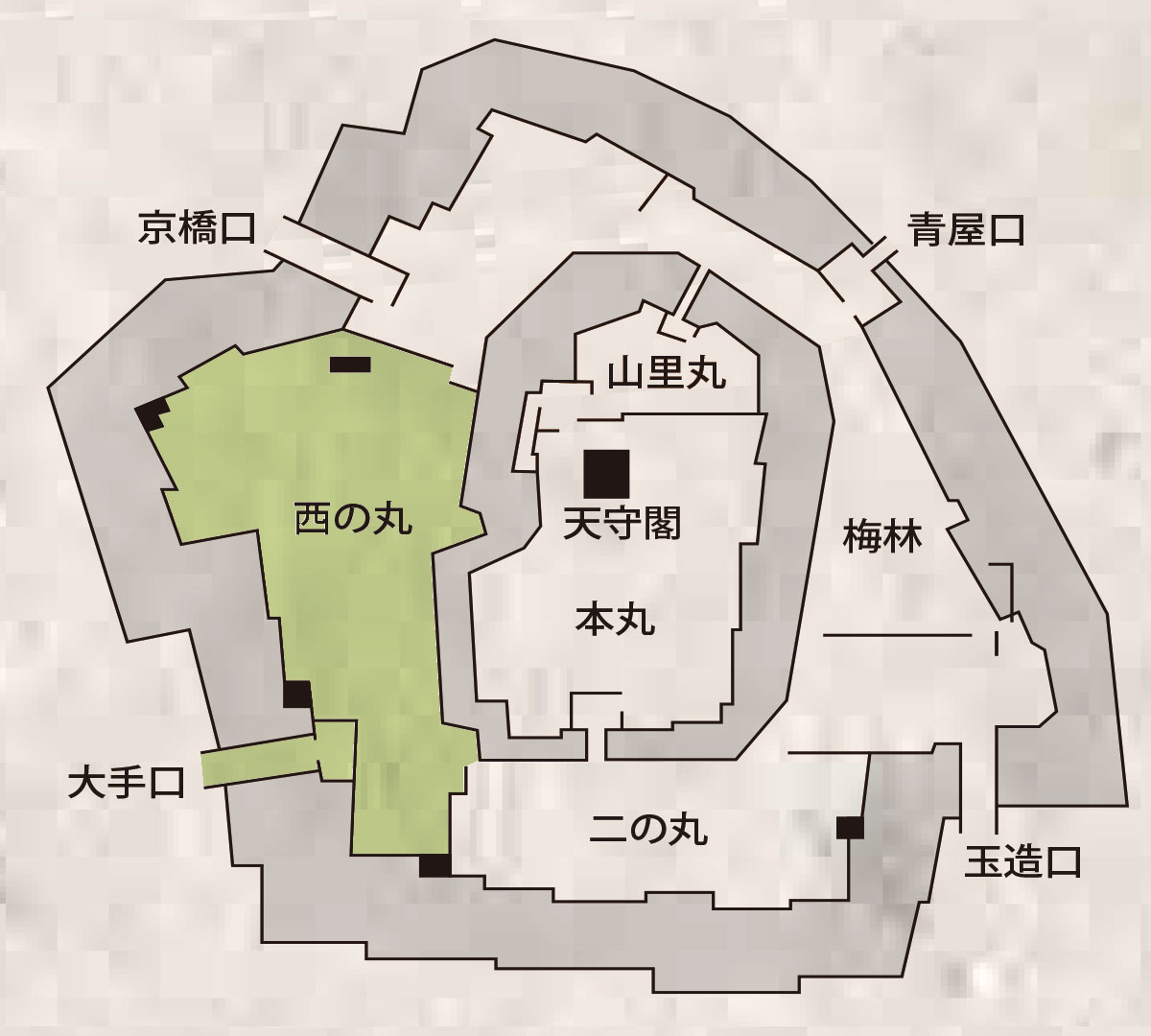Construction of the Main Tower and the Headquarters of the Fourth Army Division
Opening of Osaka Castle Park


To commemorate Emperor Showa's enthronement, donations to the value to 1.5 million Yen (value at that time) collected from the citizens of Osaka in 1931 for the reconstruction of Osaka Castle Main Tower and establishment of Osaka Castle Park. At this time, the Headquarters of the Fourth Army Division was also constructed on the castle grounds.


VIP Room

No.2 Conference Room
The Headquarters of the Fourth Army Division was a stately building, which resembled an old medieval European castle from the outside, characterized by decorative features on the upper wall portions and its front and corner turrets.

Panorama photo of Osaka Castle taken during a special large-scale army maneuver in November 1932. The Main Tower stands in the center one year after its restoration, and the welcome arch for Emperor Showa can be seen at the Oteguchi Entrance on the right
Walking through Osaka Castle
The Outer Bailey / Tamatsukuri-guchi Entrance

>tap for details

South Outer Moat
At its widest points, the moat is about 75m wide. There were seven two-storey turrets on the stone wall.

Ichiban-yagura Turret(The first turret)

Mystery Hole

Rokuban-yagura Turret(The sixth turret)

Stone wall carvings at south of Outer Bailey

Pine tree on the branch of which Priest Rennyo put his Surplice
Rennyo, the 8th head of the Hongan-ji Temple, is said to have hung his surplice here when he built the Osaka (Ishiyama) Gobo.

The Tomb for the deceased at the time of the fall of Osaka Castle
When Osaka Castle fell during the Battie of Boshin, the ashes of the retainers who perished with the castle were buried here.
Walking through Osaka Castle
Inner Bailey / Main Tower

>tap for details

Main Tower of Osaka Castle(Osaka Castle Museum)
Reconstructed in 1931, whole cost funded by donations from Osaka citizens.

Sakuramon Gate
The main gate to the Inner Bailey, reconstructed by the army in 1887. The stones on each side are called “ryukoishi” (dragon and tiger stones).

Takoishi Stone (Octopus Stone)
Largest stone in the castle. About 59 square meters wide.

Japanese Garden
Built as a garden for the Kishu-Goten Mansion, which stood in the Inner Bailey in 1931.

Kimmeisui Well Roof
Also survived the fire from lightning that consumed the Main Tower in 1665.

Kinzo Treasure House
Used to store profits from trade in Nagasaki and annual tributes paid for land directly controlled by the government in Kinai and other western Japan.
Walking through Osaka Castle
Yamazato-Maru Bailey / Aoya-guchi Entrance

>tap for details

Gokurakubashi Bridge
The name has probably been used since the days of Osaka (Ishiyama) Hongan-ji Temple. Rebuilt in 1965.

The highest stone wall in Japan
Boasts a height of 26m from the water surface and 34m from the moat bed.

Aoyamon Gate
Osaka Castle’s back gate. In the Edo period, the gate was usually closed, and access was prevented.

Place where Hideyori Toyotomi and his mother Yodo-dono committed suicide
Hideyori Toyotomi and Yodo-dono are said to have committed suicide in a turret situated here when Osaka Castle fell in the Summer War of Osaka.

Kakushi-kuruwa Bailey, stone wall carvings
The carvings indicate the construction areas assigned to each feudal lord during the Tokugawa government’s reconstruction of the castle.
Walking through Osaka Castle
Otemon Gate / Nishi-no-maru Bailey

>tap for details

Otemon Gate
Osaka Castle’s main gate. Note the intriguing joint on the right-hand pillar.


Tamon-yagura Turret at the Oteguchi Entrance
The largest tamon-yagura turret remaining in Japan. The Tamon-yagura is a long-ridged gatehouse.


Sengan-yagura Turret
One of the oldest structures remaining in the castle, along with the Inui-yagura Turret. The name probably dates back to the time of the Osaka (Ishiyama) Hongan-ji Temple.

Nishi-no-maru Garden
Nishi-no-maru is the second most important bailey after the Inner Bailey, and in the Edo period, the garden contained the Official Residence of the Osaka Castle Keepers and the Nishi-no-maru Dozo-kuruwa Bailey.

Inui-yagura Turret
A turret with an extremely rare structure: L-shaped with first and second floor of equal size. One of the oldest structures in the castle, along with the Sengan-yagura Turret.


Ensho-gura Storehouse
Osaka Castle’s gunpowder storehouse. The walls, floor, and ceiling are all built from stone.
The Passage of the Seasons




①Plum blossoms in the Snow
②Plum Grove
③Peach Blossom Garden



④Cherry Blossoms
⑤Cherry Blossoms at Night
⑥Azalea



⑦Wisteria
⑧Summer Clouds
⑨Autumn Sky



⑩Autumn Leaves
⑪Gingko Trees
⑫Sunrise Glow at Gokurakubshi Bridge


⑬Winter Forest
⑭Otemae in the Snow

Oni-gawara(Demon-shaped Ridge-end tile) of Main Tower in the Tokugawa era
Entire length: 81cm, remaining width: 92cm
Unearthed in an excavation next to the Kinzo Treasure House. The center part is inscribed with the Tokugawa crest (three hollyhocks in a circle) and the bottom is hollowed out to fit over the ridge of the roof. The hollyhock crest is about 40cm in diameter.

Gold-plated roofing tiles that adorned the Samurai Residence in Toyotomi era
17.5cm on each side
Square-shaped ornamental tiles containing the kiri-mon paulownia crest unearthed from the feudal lord’s mansion in the Toyotomi era. The tiles adorned the eaves and ridges of the building. A large number of gold-plated roofing tiles were unearthed in the area around Osaka Castle, suggesting that the whole town would appear to glow when viewed from afar.
^
PAGE TOP






















































